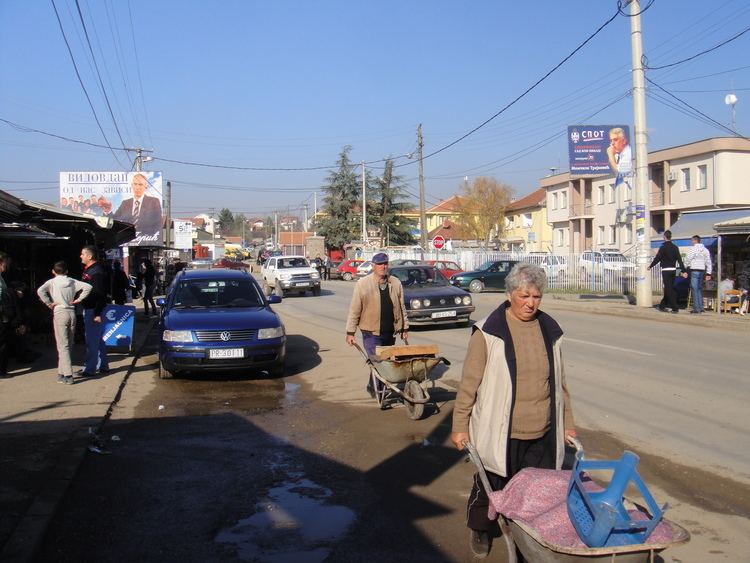Established 29 December 2009 Elevation 588 m Population 11,720 (2014) | Time zone CET (UTC+1) Area 131.2 km² Postal code 10000 | |
 | ||
Website kk.rks-gov.net/gracanice Weather 6°C, Wind N at 16 km/h, 83% Humidity | ||
Ovo je kosovo hotel gra anica
Gračanica (on Serbian, Грачаница) or Graçanica (on Albanian, Graçanicë), is a town and municipality in central Kosovo. It is centered on the Gračanica Monastery, ten kilometers east of Pristina. The 1999 Kosovo War and its aftermath transformed Gračanica from a sleepy village into an administrative center serving the needs of the 75,000 Kosovo Serbs living south of the Ibar River. After the 2013 Brussels Agreement the municipality became part of the Community of Serb Municipalities in Kosovo.
Contents
- Ovo je kosovo hotel gra anica
- Map of GraC3A7anicC3AB
- Kl ter gra anica kosovo 2016
- Geography
- History
- Municipality
- Demographics
- Infrastructure and position
- References
Map of Gra%C3%A7anic%C3%AB
Kl ter gra anica kosovo 2016
Geography
The settlement is situated in the spacious valley of the Gračanka river, by the river, on the exit of the gorge between the hill of Veletina (874m) and sloping hill of Glasnovik on the south, and hill of Steževac (794m) on the northeast.
History
Pope Benedict IX mentioned the village as Grazaniza in a letter from 1303. It was mentioned in King Stefan Milutin's founding charter of the Gračanica Monastery (1321). In the 15th century the settlement was a notable commercial centre. Until the 17th century it had a notable Ragusan community. It seems that the settlement was abandoned in 1689 during the Austrian penetration into Kosovo and Metohija in the Great Turkish War. In 1901, it had 60 houses, all Serb, with 400 inhabitants.
On 6 June, 2000, a grenade was thrown at a crowd of ethnic Serbs waiting for a bus in the town square, injuring three people, which was followed by some civil unrest. On 15 March 2004 a Serb teenager was killed in a drive-by shooting in the village of Čaglavica (partly in Gračanica). This event led to the 2004 unrest in Kosovo. In the aftermath of the unrest, another Serb teenager was killed in a drive-by shooting on June 5, 2004. In 2016, a bomb was thrown at the porch of a Serb house in Donja Gušterica.
Municipality
The municipality of Gračanica was established in 2008 by the Government of the Republic of Kosovo, out of parts of the municipalities of Lipljan, Kosovo Polje and Pristina. Although the new municipality is primarily inhabited by Serbs, this move is not recognized by the Serbian government which does not recognize the Republic of Kosovo and its administrative changes. According to the administration of the Republic of Kosovo, the name of the municipality in Albanian is Graçanicë (an Albanian transliteration).
The first municipal elections were held on 15 November 2009. The government of Serbia asked Serbs not to participate in the elections which it does not recognize, but many of them did. Serb Bojan Stojanović was elected Mayor. Town of Gračanica is also temporary seat of the administration of Serbia-recognized City of Pristina. The Serbia-sponsored local elections were held on 11 May 2008. Those elections were boycotted by the Albanians who consider Kosovo independent from Serbia, so only Serbs participated. Radovan Ničić was elected Mayor.
After the 2013 Brussels Agreement between the governments of Kosovo and Serbia, Serbia recognised the municipalities and the Republic's governance of the territory, and agreed to create an association of Serb-majority municipalities, which will operate within the Kosovo legal framework.
Demographics
The village of Gračanica is said to contain approximately 11,006 inhabitants, many of whom are Serb refugees driven out of Pristina. Differing estimates exist for the enclave as a whole, ranging from 13,000 to 11,006 inhabitants in the 15 villages that make up the enclave, and down from 120,000 in 1999. The enclave has a roughly ten-kilometer radius in which Serbs enjoy freedom of movement and attempt to organize a meaningful life for themselves.
Ethnic composition of the municipality, as of 2010:
Infrastructure and position
Gračanica has been a Serb enclave since the end of the 1999 Kosovo War, and is the largest and most secure Serbian enclave in central Kosovo. It runs along the Skopje-Pristina road, and unites several neighboring Serbian villages. The enclave, which contains rich farmland and is strategically located in the center of Kosovo, on major roads and near Pristina, has been seen as a potential threat by some Albanian nationalists, who view it as "a den of Serbian intrigue".
Gračanica has an elementary school, several small stores, an open-air market and a police station that employs ethnic Albanians and international police officers, who notably do not speak the Serbian language. The health care center is located in the central part of the town, next to the UNMIK headquarters. An elementary school was reconstructed after the 1999 war. In December 2008, the Serbian government built a €90,000 post office in Gračanica and promised further investments.
